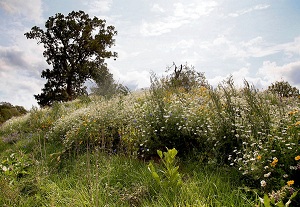
Stephen Butler, curator of horticulture, has just designed and installed a planting scheme for the African Rainforest habitat at Dublin Zoo, writes JANE POWERS
WHEN YOU ARE choosing plants for a large public space, there are particular qualities that are desirable. These might include: a long flowering period, a robust constitution, low maintenance, appropriateness for the soil, and perhaps even attractiveness to wildlife. But for one plant specifier, another criterion had to be added to the list: suitability for gorillas. Stephen Butler, who is curator of horticulture at Dublin Zoo, has just finished his latest project – designing and installing a planting scheme (including around 20,000 plants of 250 species) for a new 12,000-square-metre African Rainforest habitat.
If you haven’t been to the zoo in some time, then you are in for a surprise. The African Rainforest is the third of three great natural environments that have been created here in the past few years. The master plans for the trio were conceived by Jones and Jones of Seattle, a company specialising in wildlife and conservation habitats. The first, the Kaziranga Forest Trail – with its superb Asian elephant enclosure – is based on a region of India just north of Bangladesh. And the second, the African Savanna, is just as you would expect: all heat and dust and rusty-coloured grasses (and rhinos and giraffes).
At the heart of the new African Rainforest is the enclosure for the western lowland gorilla troop – although “enclosure” gives the wrong impression. The half-hectare space is expansive and hilly, and separated from the human side of the habitat by a watery channel and a low fence. Gorillas might consider dipping their toes into the marshy edge, but they do not swim. The contours of the land create different zones (each with its own plant community) for the occupants: warm and sheltered niches for private sunbathing, hilltops from which to scope the surrounding landscape, and fertile slopes offering a range of edibles. At the foot of the hillocks, ribbon marshes snake through the territory and are home to marginal plants such as iris, bulrush, sedge and kingcup. The landscape is based on Mbeli Bai, a 13-hectare swampy clearing in the rainforest in northern Congo, home to a healthy population of western lowland gorillas.
But this is Ireland, not Africa, so an entirely new planting palette had to be formulated with species that are suitable for our climate, and that also look as jungly as possible. The visitor – when the plantings mature – will be immersed in big-leaved and exotic, rainforest-like vegetation.
Within the gorillas’ area, the selection is further fine-tuned. It includes plants that the primates can eat, but not annihilate; plants that are unpalatable, and that will be left alone, and plants that are not poisonous, except for those that the gorillas already know to avoid. “At last count,” says Stephen Butler, “there were 15,511 plants of 200 different species.”
For him, the challenge of choosing these plants was as much about animal behaviour and diet as about horticulture. “Gorillas are vegetarian. They will eat almost everything. But they won’t eat things that are too smelly, and they won’t eat things that are too prickly.” So, lavender, catmint and the shrub Choisya are probably too aromatic, while berberis, holly and echium are too prickly or hairy – he hopes.
Some of the plants were recommended by colleagues at American and European zoos, while others were the product of his own research and deductions. For instance, squirrel monkeys, – which devour almost anything – won’t touch hornbeam; geese won’t eat elecampane (Inula helenium); elephants don’t bother browsing on the big-leaved foxglove tree (Paulownia tomentosa); and rabbits shy away from the purple willow (Salix purpurea) because it contains so much bitter salicylic acid.
All of these have been planted in the gorillas’ garden as part of a wait-and-see, fingers-crossed strategy. The largest specimens are several Caucasian wing nut trees (Pterocarya fraxinifolia), which are related to walnuts. “We tried feeding it to various animals, including goats, and they won’t eat it. The nice thing is that it suckers. So, if it doesn’t get eaten, we’ll have a whole thicket.”
There are plenty of dead trees here too, including two previously mighty oaks. These span gaps between the mounds, or just lie around looking romantically gothic. When trees fall or become dangerous in the Phoenix Park, the zoo often requisitions them to enrich the various animal habitats.
Many of the plants are edible, and are resilient species that will regenerate after being grazed: comfrey, clover and plantain, for example. Autumn-fruiting raspberries, originally from Butler’s own garden, provide succulent treats. He hopes that the prickles will deter the foragers from eating the canes. Underfoot, the grass – rhizomatous tall fescue from southern France – is deep-rooting and drought-resistant. It is edible, but is threaded through with dozens of wildflower species including yarrow, bugle, kidney vetch, lady’s bedstraw, field scabious and ox-eye daisy.
All of these will be examined by the gorillas before they decide whether to sample them or not, so snacking on the grass will be a time-consuming and leisurely activity.
The gorillas’ plot is surprising pretty, a bit like a Gainsborough painting, with its shaggy hills and picturesquely ruinated trees. It looks good to humans, but more importantly, it offers its inhabitants a stimulating and sympathetic place to ramble around, to hunt for food, and to have some quiet moments.





